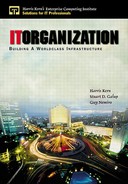Bibliography
Axelrod, R. (1984). The Evolution of Cooperation. New York: Basic Books.
Beck, N. (1992). Shifting Gears: Thriving in the New Economy. Toronto: HarperCollins.
Borthick, A Faye; Roth, Harold P. “Understanding client/server computing,” Management Accounting (76:2), August 1994, pp.36-41.
Bridges, W. (1994). JobShift: How to Prosper in a Workplace without Jobs. Reading, MA: Addison-Wesley Publishing Company.
Cascio, W. (1992). Managing Human Resources (3rd ed.). New York: McGraw-Hill.
Davis-Blake, A., and Uzzi, B. (1993). “Determinants of employment externalization: A study of temporary workers and independent contractors,” Administrative Science Quarterly, 38, 195-223.
DeSantis, G., Jackson, B. “Coordination of information technology management: Team-based structures and computer-based communication systems,” Journal of Management Information Systems (10:4), 1995, pp. 85-110.
Diamond, S. “Client/server: Myths & realities,” Journal of Systems Management (46:4), July/August 1995, pp. 44-48.
Doeringer, P., and Piore, M. (1976), Internal Labor Markets and Manpower Analysis. Lexington, MA: C. Heath and Company.
Donaldson, L. (1990). “The ethereal hand: Organizational economics and management theory.” Academy of Management Review, 15, 369-381.
Duchessi, P., Chengalur-Smith, I. “Client/server benefits, problems, best practices.” Communications of the ACM (41:5), May 1998, pp. 87-94.
Fitzgerald, J., and Dennis, A. Business Data Communications and Networking, John Wiley & Sons, Inc., New York, 1996.
Galup, S., Saunders, C., Nelson, and Cerveny, R. “The Use of Virtual Staff and Managers in a Local Government Environment,” Communication Research (24:6), December 1997, pp. 698-730.
Granovetter, M. (1974). Getting a Job: A Study of Contacts and Careers. Cambridge, MA: Harvard University Press.
Griesing, D. (1990). “The human side of economic organization.” Academy of Management Review, 15, 478-499.
Hackman, J. R., and Oldham, G. R. (1980). Work Design. Reading, MA: Addison-Wesley Publishing Company.
Hennart, J. F. (1993). “Explaining the swollen middle: Why most transactions are a mix of 'Market' and 'Hierarchy.'” Organization Science, 4, 529-547.
Kanungo, R. N. (1982). “The measurement of job and work involvement.” Journal of Applied Psychology, 67, 341-349.
Krackhardt, D., and Kilduff, M. (1990). “Friendship patterns and culture: The control of organizational diversity.” American Anthropologist, 92, 142-164.
Krackhardt, D., and Porter, L. (1985). “When friends leave: A structural analysis of the relationship between turnover and stayers' attitudes.” Administrative Science Quarterly, 30, 2424-261.
Krackhardt, D., and Porter, L. (1986). “The Snowball Effect: Turnover embedded in communication networks.” Journal of Applied Psychology, 71(1), 50-55.
Krackhardt, D., and Stern, R. N. (1988) “Informal networks and organizational crises: An experimental simulation.” Social Psychological Quarterly, 51, 123-140.
Kern, H., and Johnson, R. (1994). Rightsizing the New Enterprise: The Proof, Not the Hype, Sun Microsystems Press—Prentice Hall, California.
Kern, H., Johnson, R., Hawkins, M, Lyke, H., Kennedy, W., and Cappel, M. (1995). Networking The New Enterpise: The Proof, Not the Hype, Sun Microsystems Press—Prentice Hall, California.
Kern, H., Johnson, R., Hawkins, M., and Law, A. (1996) Managing the New Enterprise: The Proof Not the Hype, Sun Microsystems Press—Prentice Hall, California.
Kern, H., Johnson, R., Galup, S., and Horgan, D. (1998). Building the New Enterprise: People, Processes, and Technology, Sun Microsystems Press—Prentice Hall, California.
King, Julia “Mainframers win ticket to ride client/server bus,” Computerworld (28:30), July 8, 1996, pp.1 and 16.
Kliem, R. “Managing the People side of client/server architecture,” Journal of Systems Management (47:1), January/February 1996, pp.24-28.
Lindberg, L. N., Campbell, J. C., and Hollingsworth, J. R. (1991). “Economic governance and the analysis of structural change in the American economy.” In J. C. Campbell, J. R. Hollingsworth, & L. N. Lindberg (Eds.), Governance of the American Economy, New York: Cambridge University Press.
Lee, Denis M S; Trauth, E. M; Farwell, D. “Critical skills and knowledge requirements of IS professionals: A joint academic/industry investment,” MIS Quarterly (19:3), September 1995, pp. 313-340.
Magnum, G., Mayall, D., and Nelson, K. (1985). “The temporary help industry: A response to the dual internal labor market.” Industrial Labor Relations Review, 38, 599-611.
Mahoney, J. T. (1992). “The choice of organizational form: Vertical financial ownership versus other methods of vertical integration.” Strategic Management Journal, 13, 559-584.
Martin, Richard J. “In praise of old dogs,” Journal of Systems Management (45:12), December 1994, pp.57-59.
Merton, R. K. (1968). Social Theory and Social Structure (Enlarged Edition). New York: Free Press.
Nelson, R. E. (1986). “Social networks and organizational intervention: Insights from an area-wide labor-management committee.” Journal of Applied Behavioral Science, 22, 65-76.
Nelson, R. E. (1989). “The strength of strong ties: Social networks and intergroup conflict in organizations.” Academy of Management Journal, 32, 377-401.
Nelson, R. E., and Mathews, K. M. (1991). “Social networks of high performing organizations.” Journal of Business Communication, 28, 367-386.
Nelson, R. E., and Mathews, K. M. (1991). “The use of cause maps and social network analysis in organizational diagnosis.” Journal of Applied Behavioral Science, 27, 379-397.
Ouchi, W. (1979). “A conceptual framework for the design of organizational control mechanisms.” Management Science, 25, 833-848.
Palm Beach County Technology Transformation Plan, April 10, 1995.
Perrow, C. (1986). Complex Organizations: A Critical Essay (3rd ed.). McGraw-Hill, Inc: New York, NY.
Powell, W. (1990). “Neither market nor hierarchy: Network forms of organization.” In Barry Staw and L. L. Cummings (Eds.) Research in Organization Behavior: Vol. 12, pp. 295-336. Greenwich, CT: JAI Press.
Provan, K. (1993). “Embeddedness, interdependence, and opportunism in organizational supplier-buyer networks.” Journal of Management, 19, 841-856.
Saunders, C., Hu, Q., and Gebelt, M. (1997). “Achieving success in information systems outsourcing.” California Management Review, 39 (2), 63-79.
Schulte, R., “Middleware and Three-Tier Architectures” GartnerGroup Symposium/Itxpo 95: Managing the Revolution, October 9-13, 1995, Day 5.
Sims, H. P., Szilagyi, A.D., & Keller, R. T. (1976). “The measurement of job characteristics.” Academy of Management Journal, 19, 195-212.
Uzzi, B. (1997). “Social structure and competition in interfirm networks: The paradox of embeddedness.” Administrative Science Quarterly, 42, 35-67.
Walker, G., and Weber, D. (1984). “A transaction cost approach to make-or-buy decisions”. Administrative Science Quarterly, 29, 373-391.
Williamson, O. (1981). “The economics of organization: The transaction cost approach.” American Journal of Sociology, 87, 548-577.
Weston, R. “Client/server evolution: Thin clients, fat servers,” Computerworld (32:6), February 9, 1998, p. 20.
